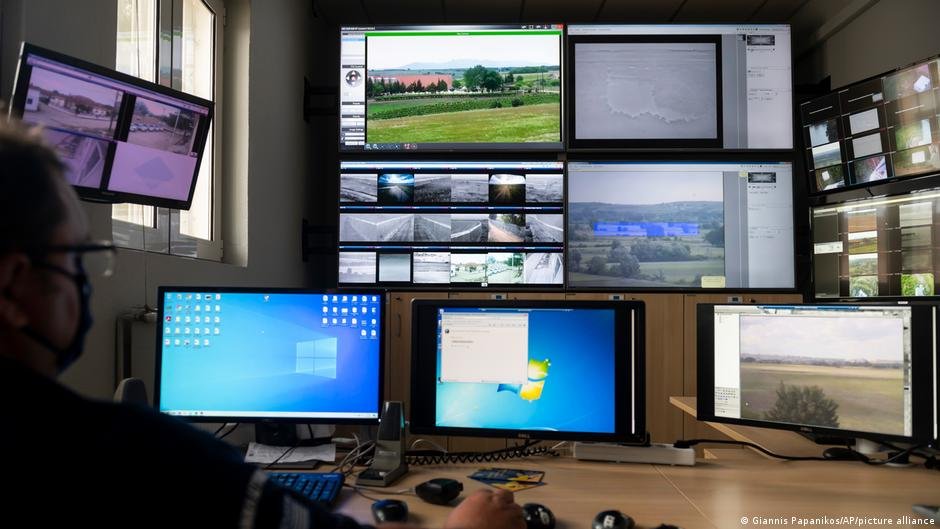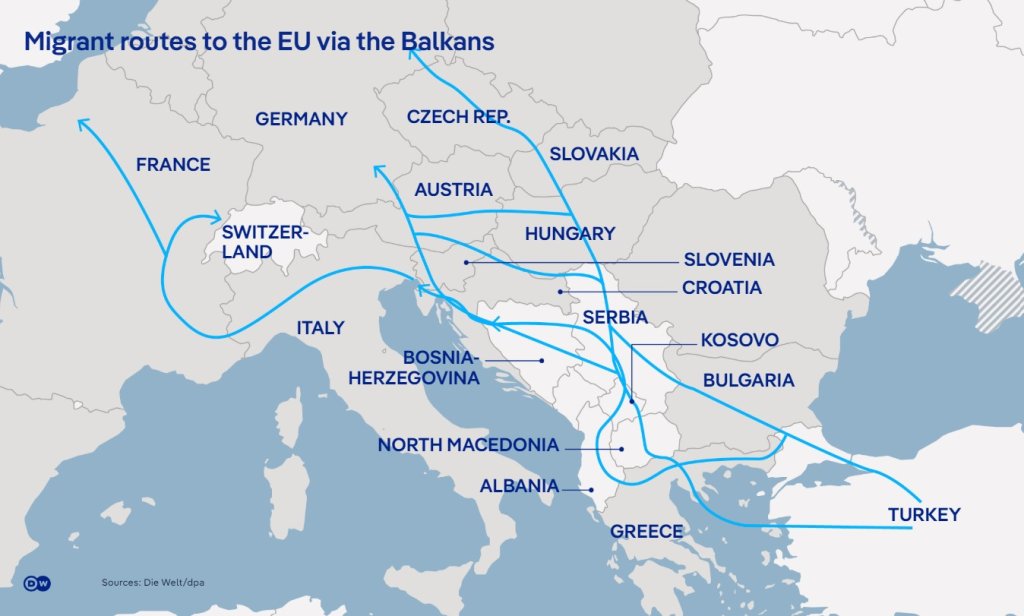As AI-driven border technology expands, migrants and smugglers adapt. Does surveillance deter crossings or only push routes elsewhere? In this interview, researcher and freelance journalist David Suber -- an expert on organized crime, people smuggling and border policing -- explores the dynamics of border enforcement, its risks and its unintended consequences.
InfoMigrants: Along parts of the EU's external borders, there have been test pilot phases of (AI-driven) technology, some of it controversial. What are your observations about border technology?
David Suber: What I've observed over the last few years is a growing interest in using border technology by governments, law enforcement agencies, and private security companies developing border tech for surveillance and security. There's a lot of hype around the use of technology for border enforcement. However, based on what I’ve seen and researched, the practical implementation of border tech is hard to research. It is hard to show how different technologies are being applied across whole border areas, countries and regions. The evidence of their application is much more patchy than what we might think, and is mostly focused on specific hotspots and border crossings.
However, the political interest in using and developing more technological resources to surveil and patrol borders is as strong as ever, and therefore the interest also from private firms to develop, sell and profit from this technology. There is a big economy (supply) and a big market demand.
How have smugglers and migrants dealt with and adapted to the technological surveillance at the EU external borders with drones and cameras so far?
Migrants and facilitators -- so-called smugglers -- are aware of the new technologies, even though they’re designed to be hidden. From interviews across different borders, my understanding is that they are also aware of how patchy it is, with some areas heavily monitored and others almost empty. Groups adapt their organization to overcome challenges. For example, in the Balkans, some areas are equipped with sensors (sound and movement) and drones that are used to locate and follow the movement of people in forests. Law enforcement uses this information to intercept groups at road crossings. Migrants respond with simple techniques: waiting (patience) to outlast officers, retracing their steps, or using multiple guides, where one scouts ahead to check if the route is clear. These low-tech responses to high-tech surveillance sometimes work and sometimes don’t.
So it's a cat-and-mouse game with mixed results?
I would say yes, and I would add that these technologies aren’t necessarily designed to stop everyone but to increase the risk of detection and apprehensions/arrests, as well as the perception of surveillance. This is done to try and have an effect in deterring future crossings, rather than stopping smuggling from happening at present.
Detection is for a particular group to actually be stopped on the border before they cross; surveillance is for an overall awareness from law enforcement of knowing that there are people crossing that specific point in time. For law enforcement, increasing their capabilities makes sense because they believe in the deterrence effect that higher risks of being caught will have on migrants and smugglers.
However, whether deterrence works is not strongly supported by empirical research. Actually quite the contrary. Empirical research suggests that deterrence doesn’t significantly impact migrants and smugglers’ decision making. The deployment of technology is also a resource issue – law enforcement can’t deploy sophisticated border tech everywhere, as this is too costly, and they also know this won’t stop everyone.
Read AlsoConcerns over 'jail-like conditions' and invalid technology under EU Pact

Smugglers adapt by any means necessary. How far do they go logistically and morally?
There are limits. Smuggling is a very stressful job. Smugglers coordinate operations from start to finish, often on call the entire time. Often smugglers are only being paid once the group successfully arrives at its intended destination. Failures -- like missing group members -- can lead to disputes with families or unpaid fees. This stress drives many experienced smugglers to quit, which then creates openings for less experienced smugglers or other criminal groups to fill in those gaps. A more inexperienced smuggler will get more precarious boats, will not know how to deal with the better organization of all the equipment that is necessary for fuel, engines, or will just have lesser knowledge of how to deal with an emergency situation.
It is hard to tell whether these are intended effects of the border policies designed by states. But one of the effects that can be observed on different borders is that the continuation of this cat and mouse game between smugglers and border police forces, at a certain point drives the most experienced smugglers out of the game. They get tired and move on to something else. And to see this as a victory of law enforcement is a very simplistic way of understanding the phenomenon, because that spot is taken by other facilitators, and this raises the risks of people crossing, or by other criminal groups, which might involve other more violent means to manage the smuggling. The passing over between experienced and inexperienced smugglers is one of those unintended consequences that border enforcement has been leading to, which ultimately leads to more vulnerability and deaths at the border, not necessarily to net reductions in irregular border crossings, and surely not to a reduction in border deaths and a number of missing people.
Given the lack of legal pathways to Europe, will there always be a need for smugglers?
Many current policies are designed to deter migration by focusing on reducing the supply rather than addressing the demand. These policies target supply through counter-smuggling measures: increasing detection, imposing harsher penalties, pursuing stronger prosecutions, and raising the risks of arrest. This approach assumes that irregular migration exists primarily because of smugglers facilitating it, but this is fundamentally flawed logic.
The evidence from the past 20 years shows that when demand grows -- because more people need to move -- the supply adapts. Smugglers find new ways to meet this need, leading to higher costs, riskier routes, and more deaths along the way. Even if the number of entries into the European Union drops in a given year, we must ask: how is Europe defining "victory"? Is it a reduced number of people entering, while more people drown at borders?
Additionally, in neighboring countries, undocumented and irregular migrants often accumulate in greater numbers. This creates political leverage for these countries, allowing them to apply pressure on the EU by threatening or triggering border crises, as we saw with Turkey in 2020 and Belarus in the summer of 2021.
Routes are becoming longer, more fragmented, and more dangerous. Does the smuggling business reflect this?
Yes, especially on the most established routes. If word gets out that a particular border is very complicated to cross, it might lead people to try and cross somewhere else -- where very little enforcement is being deployed. And at that point the wheel will have to be reinvented again. It may start from very low prices. As that border again gets more securitized, prices are driven up, and migration pushed somewhere else.

Read AlsoBusting myths about migration to help create better policy
Do smugglers care for migrants, or are they mostly exploitative?
There has probably been a self-selection bias in the smugglers that agreed to talk to me, because they rarely admitted to being ruthless, violent or exploitative. They spoke of themselves as operating in a high-stress environment, which can lead to bad decision making, which can lead to problems, which can then lead to violent confrontations where their own life is at risk.
But yes, exploitation exists of course, and there’s a risk of it existing more and more as business goes more underground. But we tend to conflate traffickers with smugglers. There is a key difference between the two: traffickers are those exploiting migrants, for example in Libya, where people are tortured for extortion and then let go on boats only once their families and friends pay money. Smugglers instead act more like service providers. They are not engaged exploitation, and their crime is that of breaching a state’s borders, not a crime against a person. Now, there is a smuggling element in the exploitation of people on the move. For example, militias or groups in Libya that kidnapped people for ransom, put them in detention, exploit them for work, exploit them for getting remuneration from their families in order to set them free and then also put them on a boat to Italy. The smuggling element is just one part of the whole exploitation circuit they are involved in. But in many other locations, smugglers are literally facilitators, taking people from A to B -either themselves or through organization of a group, network.
Read AlsoThe cruel reality of migrant detention and deportation in Libya
Are there any other risks migrants face once they are deep into their journey?
Scams happen all the time. The risk of making an agreement with someone who then tells you ‘you go and deposit money at this hawala agency office’, and then the money disappears, or for example debt bondage, being able to only travel because you are indebting yourself to a group or an individual, knowing that you are going to have to pay that money back.
Plus being told false information and then getting stuck -- like being told Belarus or Russia is easy to cross, only to get stuck.
Unaccompanied minors are often in a more vulnerable position than others when selected to be the boat drivers, as there is often a false assumption that children might be treated differently by border authorities if or when caught steering a dinghy, or given lighter sentences than adults. This is a risk many minors go through when crossing the Channel to the UK, or the Eastern Mediterranean between Turkey and the Greek islands, for example. And we are seeing it reflected in the criminal justice system, when many children are not believed to be underage, their age assessments are brushed aside as a bureaucratic nuisance and they get prosecuted as adults and sent to adult prisons.
Editor's note: This interview was conducted in August 2024. It has been shortened and edited for clarity. Some wording was revised in an update on April 30, 2025, at the request of the interview partner.
